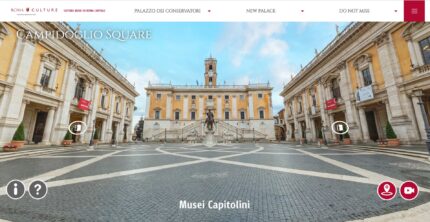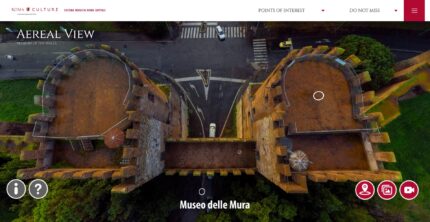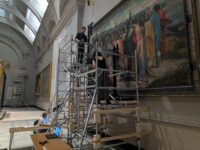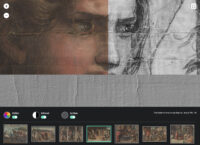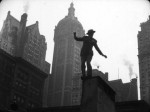 Too Much Johnson was one of Orson Welles’ innovative theories that failed so thoroughly in practice that audiences wouldn’t get to see it for 75 years. It was meant to be an accompaniment to a play of the same name, an 1894 farce of adultery, false names and mistaken identity adapted from a French original by William Gillette who would go on to become hugely famous portraying Sherlock Holmes on stage more than 1,300 times. Welles’ theatrical company, The Mercury Theater, was staging the play with his trusty stable of actors including Joseph Cotten and Arlene Francis. His idea was to create a Keystone Kops-style slapstick silent movie introduction before each of the three acts. He filmed it on shoestring budget in 10 days and edited 25,000 feet of highly flammable nitrate film in a hotel room to create a 66-minute rough cut.
Too Much Johnson was one of Orson Welles’ innovative theories that failed so thoroughly in practice that audiences wouldn’t get to see it for 75 years. It was meant to be an accompaniment to a play of the same name, an 1894 farce of adultery, false names and mistaken identity adapted from a French original by William Gillette who would go on to become hugely famous portraying Sherlock Holmes on stage more than 1,300 times. Welles’ theatrical company, The Mercury Theater, was staging the play with his trusty stable of actors including Joseph Cotten and Arlene Francis. His idea was to create a Keystone Kops-style slapstick silent movie introduction before each of the three acts. He filmed it on shoestring budget in 10 days and edited 25,000 feet of highly flammable nitrate film in a hotel room to create a 66-minute rough cut.
It was never shown. The Stony Creek Theater in Branford, Connecticut, where the play was staged, was not equipped to project the film. Welles had heavily edited the play to blend seamlessly with the filmed intros, so without it the theatrical production flopped too. That was August 1938, a month after the Mercury Theater’s radio productions began, two months before one of those radio productions would adapt a certain H.G. Wells alien invasion story into a news broadcast style and make headlines around the country. Suddenly very much in demand, Orson Welles packed up the 10 reels of Too Much Johnson and went on with his life, cutting the sweet deal with RKO that would result in his immortal third movie, Citizen Kane.
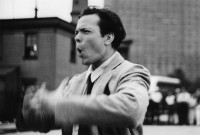 He thought the never-seen experimental film had been destroyed in a fire at his home in Madrid in 1970, but thankfully he was wrong about that. Too Much Johnson, all 10 reels of it, was found in a crate of old Welles films that had been abandoned in the Pordenone warehouse decades earlier. Nine of the reels were in surprisingly good condition. The tenth was decomposing rapidly and had to receive specialized treatment by film conservators.
He thought the never-seen experimental film had been destroyed in a fire at his home in Madrid in 1970, but thankfully he was wrong about that. Too Much Johnson, all 10 reels of it, was found in a crate of old Welles films that had been abandoned in the Pordenone warehouse decades earlier. Nine of the reels were in surprisingly good condition. The tenth was decomposing rapidly and had to receive specialized treatment by film conservators.
The film society that rescued and identified the collection in the shipping warehouse crate reached out to the George Eastman House in Rochester, New York, which is world-renown for its film conservation department. They secured a grant to restore the picture and in October 2013, Too Much Johnson finally had its world premiere at a silent movie festival in Pordenone. It made its US debut days later at the George Eastman House in an exclusive showing for museum members. Too Much Johnson had its cable television premiere on Turner Classic Movies in May 2015. The National Film Preservation Foundation digitized the restored film and made it available online with notes on the sidebar explaining how the film was designed to interact with the play.
The Eastman showings had special features only seen there, including a new piano score by Philip C. Carli who used the original Mercury Theater stage score for inspiration, and a voice-over commentary by Anthony L’Abbate, preservation manager, and Caroline Yeager, associate curator, of the George Eastman Museum who worked on its restoration. The museum has now released their special edition of Too Much Johnson on Vimeo.
“For the first time, people from all over the world will have access to this unique material with the voice-over commentary and musical accompaniment, previously only available for in-person screenings,” said Peter Bagrov, curator in charge, Moving Image Department, George Eastman Museum. “The original commentary was written by the museum and has been performed all over the world. It is essential for the understanding of this unfinished work by one of the great masters of cinema; the context it provides enhances the viewing experience for everyone.”
The voice-over commentary includes a story of the print’s discovery and the meticulous preservation process, as well as the history of the film’s creation—its casting, the filming locations in New York City (many of which are now gone), and why it never made it to the big screen.
It opens with a brief introduction about the film’s conservation and the research that went into piecing together how the film was shot. At 6:44 the movie begins, and as someone who has watched three versions (the TCM version, the NFPF version with side notes and this one), I can unequivocally state that this voice-over commentary is essential. It adds so much to the viewer’s understanding of the movie, what is going on in the story, where the scenes are being filmed. It turns a fascinating glimpse into Welles’ nascent directorial genius into a full-featured documentary. I wish every commentary were recorded by film conservators instead of woolgathering directors and verbose actors.
Watch it here.
 I was reminded of this exchange when watching the highly entertaining and illuminating webinar Love, Lust, and Libido: Aphrodisiacs in Medieval Europe hosted by food historian Ken Albala and Getty manuscripts curator Larisa Grollemond. Albala explanes the Humor Theory and how inextricably linked it was to food which was not just a menu but medicine. What foods you were allowed to eat while doing penance for sexual sins was determined by the humors, because some ingredients — ginger, meat, salt — stimulated libido/performance/fertility while others — spinach, beans, fruit — suppressed them. Grollemond adds some visual aids in the form of manuscript illuminations from the Getty’s collection. It is an impressively thorough and eminently watchable treatment of the question.
I was reminded of this exchange when watching the highly entertaining and illuminating webinar Love, Lust, and Libido: Aphrodisiacs in Medieval Europe hosted by food historian Ken Albala and Getty manuscripts curator Larisa Grollemond. Albala explanes the Humor Theory and how inextricably linked it was to food which was not just a menu but medicine. What foods you were allowed to eat while doing penance for sexual sins was determined by the humors, because some ingredients — ginger, meat, salt — stimulated libido/performance/fertility while others — spinach, beans, fruit — suppressed them. Grollemond adds some visual aids in the form of manuscript illuminations from the Getty’s collection. It is an impressively thorough and eminently watchable treatment of the question.